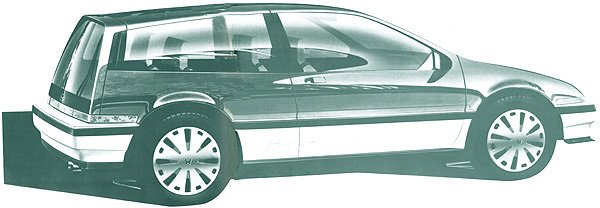I would rock that concept car

US imported Hondas starting in 1968. The 200 and 600 came in then. Then in 73.5 Honda California brought in the CVCC 800, with CVCC the valves provide a swirl for intake and exhaust.
VTEC was made by the Formula team to broaden the powerbands on it's F1 car. A 1.6 liter V12 turbo motor built by Mugen / Honda. VTEC was seen in the B16A in Japan in 1989, but not in the US until the NSX. Acura was a company set up in the US so Honda could sell upscale car trims without the Honda logo on them. Remember, in 1989 Americans were protesting Japanese made things, with a huge "Buy American" slogan. This went all the way to Congress, who began placing huge tariffs and rules on Japanese imports. After a while, Congress was so bold to put huge restrictions on car NAMES. Instead of an "East asian import" they would say the brand directly "Honda".
The NSX wasn't allowed on US roads because of it's small headlights. The law passed down was that "Honda" would not bring the NSX in. So Acura did.
The US lawmakers were pissed that Honda had "Found loopholes and circumvented" them. The truth being, Honda was doing whatever it could to work WITHIN the guidelines and get their cars here. over 60% of NSXs were sold to banks as assets and never driven. They remain that way to this day.
in 1990 the US sat down and worked up the toughest anti-importing schemes ever. That's why in 1990 you won't find an MR2, RX7 coupe, or other notable japanese imports. Safety ratings and even layout ratings prevented these cars from seeing US soil until a major redesign. Mazda, Toyota, Honda, and Mitsubishi saw major design changes from 1990-1993. Korean makers like DAEWOO and other East Asians like Hyundai weren't making the changes - And it nearly cost them their business. By 1992 the companies were back on the same page with the US.
Note, that US companies in this time didn't have to adhere to the same safety standards that the Japanese did. This was to be their ultimate undoing.
When Honda brought the newly-safety engineered Odysee to the US, it claimed the very thing that the US made it claim - "The safest Minivan in the world". Toyota Camrys and Honda Accords were also tagged with this. The result is that Japanese were now selling cars double, even triple fold over US cars. They were getting better mileage, lasting longer and proved that smaller didn't mean less comfortable nor less safe.
In 1992 Honda made the move to incorporate VTEC in it's second generation (mild differences in controller) (correct me if I'm wrong here) into two strange choices. The Prelude (Then flagship car of the Honda lineup) and the lower-end Civic Si. To incorporate a cutting edge system into a flagship car is common - But no one expected the Civic to get VTEC. Now Honda dominated the market segments with the Accord, the Civic and the Odyssee. A trend that continues 10 years later.
Honda is NOT the only maker with a variable valve timing system. Each manufacturer has had similar designs since the Studebaker memory-metal springs that would stop contracting after a certain temperature to avoid valve lash. We're talking like, early 60's tech. Toyota had TVIS, which drew in more air lower RPMS and allowed for more efficient high-RPM fuel mixing. Toyota now uses it's VVTL system, which works in a mechanical sense to change the cam attitude. Fords Ecotec valve management uses a VTEC-like cam lobe, but ONLY affects the exhaust cam.
Now Nissan has a neat system, called "NEO-VVL". NEO VVL works like VTEC (It selects a new cam profile). But it also solenoids the cam up and down (ala Toyota's VVTL) Resulting in a triple cam power band. Imagine VTEC then "Super VTEC".
All of this stuff is "Basically said" and I'm sure I'm not correct on several points. But it's a basis to read up on.
-> Steve





 A 1.6 liter V12 turbo motor built by Mugen ? WTH that must be a resposive ass 12 cylinder
A 1.6 liter V12 turbo motor built by Mugen ? WTH that must be a resposive ass 12 cylinder 
 X 1google
X 1google